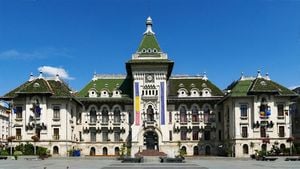Russia's housing sector made significant strides at the outset of 2024, with over 1,500 apartment buildings undergoing major renovations. According to the Russian Territorial Development Fund (FRT), January alone saw the completion of 1,563 buildings, covering 6.9 million square meters and benefiting approximately 244,400 residents. With construction limitations due to seasonal factors, this progress emphasizes the sector's determination to improve living conditions.
Ilshat Shagiahmetov, the general director of FRT, reported, "The possibility of conducting major repairs has limitations due to the season. Nevertheless, builders managed to repair 1,563 multi-apartment houses during January, providing work on areas like sloped roofs and engineering systems, as well as elevator replacements." This commitment was reflected during the winter months, traditionally regarded as less favorable for construction work.
Last year, the FRT noted ambitious efforts: over 25,000 residential buildings were extensively renovated as part of the broader program initiated in 2014, which currently operates across 85 regions of Russia. Regional authorities are tasked with monitoring the implementation of housing repairs, ensuring prioritized actions based on the technical condition of the buildings.
The infrastructural recovery is backed mainly by citizen contributions to the capital repair fund, which reflects localized responsibility and community involvement. With contracts for renovation work already exceeding 300 billion rubles for 2025, this budget is approximately one-third more than the previous year, showcasing growth potential within the sector.
This maintenance work not only enhances living conditions but is also pivotal for local economies, generating employment opportunities and improving community spaces. It serves as both practical needs and government initiatives intertwine to deliver sustainable urban living.
Reportedly, the 2025 refurbishment contracts are already underway, with regions ramping up their tender processes since late last year. Shagiahmetov highlighted this urgency, stating, "The regions have actively started large-scale actions to facilitate repair work for residential buildings, thereby responding to the heightened need for efficient housing solutions." The housing overhaul program has become increasingly reactive, adapting to feedback from the community and their living standards.
Despite the existing challenges, including seasonal work constraints, the FRT's findings indicate optimism within this sector. Volunteers, citizens, and local organizations contribute to dialogue around housing needs, emphasizing collective responsibility for community welfare.
Experts suggest this move to prioritize housing repairs can significantly influence public perception of governmental efficacy. Fulfilling housing restoration promises reflects on broader political leadership, particularly as residents face the tangible benefits of improved infrastructure.
Monitoring and evaluation will be instrumental as the FRT continues to oversee renovations, utilizing resident feedback from these communities to direct future funds. The necessity to adapt based on residences' needs stands pivotal as stakeholders remain engaged with the community throughout this transformative process.
The overarching narrative presents housing repairs as more than mere infrastructural work; they represent the desires and voices of citizens. Government engagement plays a role, shaping initiatives to adequately respond to these collective demands.
Comparatively, this resonates with broader Ukrainian contexts, where similar systematic improvements are reported, showcasing the direct impacts of governmental infrastructure initiatives across the region. Strengthened ties between the central government and local communities could forge pathways for not only housing improvements but also broader socio-economic advancements.



